Philadelphia Suburban Transportation Company
Red Arrow Lines
Into the early 1980's, SEPTA's Red Arrow trolley system
qualified as an operating trolley museum. The Red Arrow division regularly operated
ancient trolleys in Delaware County, just west of Philadelphia, from three fleets
built between 1932 and 1949. These traditional suburban trolley lines continue
in service today, albeit with newer equipment.
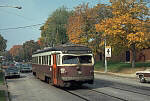
| The Philadelphia Suburban Transportation Company trolley system was absorbed
into the SEPTA system in 1970. Its two remaining trolley routes, to Media
and Sharon Hill, used 1930's and 40's vintage double-end trolleys until
the arrival of new Light Rail Vehicles in 1981.
St. Louis no. 20 southbound on Woodlawn Ave., October 20 1979. photo
© Mike Szilagyi
|

| The "newest" equipment on the Red Arrow lines were these St. Louis-built
cars, built in 1949. Even after the postwar body was made standard, St.
Louis Car continued to use a variant of the old, 1935-style carbody whenever
it built double-end equipment. Differences from the standard pre-war carbody
included the vertical dash panel and 24 degree sloped windshield, intended
to remove glare from the glass at night. The later "grommetization" of the
windshield gave these interurbans a tank-like appearance.
St. Louis no. 17 at 69th St. Terminal, October 1979. photo © Mike Szilagyi
|
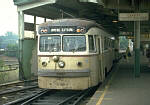
| The very last trolleys built by Philadelphia's once-great Brill Car Company were these ten
suburban cars, completed in 1940. Instead of paying royalties to the Transit Research
Corporation to build PCC cars, Brill decided to build a competing trolley of its own design.
Unfortunately, the boxy, riveted Brill car never did catch on. Only three Brilliners were built for Brill's traditional best customer, the PRT (PTC's predecessor). The twenty-four
car "Miss America Fleet" built for Atlantic City in 1939 was the largest order of Brilliners.
Brilliner 4 at 69th St. Terminal on June 15, 1977. photo © Mike Szilagyi
|
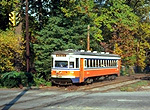
| The last traditional (hand-controlled) streetcars in service in the Philadelphia area were
these Brill "Master Unit" suburban cars built in 1932-33. They were capable of seventy miles
per hour, and lasted into the early 1980's. Both the Media and Sharon Hill lines offer a wide
variety of operation, ranging from private right of way, to side of the road, to traditional
streetcar operation. These two suburban trolley lines continue in service today, with heavy (read slow) double-end Kawasaki light rail cars.
Brill master unit no. 78 on the Media line near Springfield Mall in 1980. photo © Mike Szilagyi
|
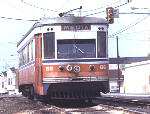
| As was the case with the St. Louis interurbans, the appearance of the
cars was drastically altered when the windshields were re-built (the center
glass originally extended up to the destination sign). These trolleys tended
to be used only during rush hours by 1980. The Buckingham Valley Trolley
Association is one group that preserved a car of this series; today it survives
at Electric City Trolley Museum in Scranton Pennsylvania.
Brill master unit no. 86 on the West Chester Pike storage track on November 20, 1979. photo © Mike Szilagyi
|
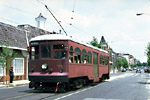
| In marked contrast to modern trolleys like the Brilliners and Master Units
described above, the Brill "Center Door" car seen here was typical of suburban
trolleys built around 1920. These tended to be large, heavy, double-end
cars, with passengers entering and exiting via doors located at the center
of the car. When this car was ordered in 1926, its design was already "conservative"
to put it mildly. In a further concession to tradition, this order of cars
was designed with arched upper windows, in an attempt to evoke the image
of the luxurious interurban trolleys that had been built during the first
decade of the 20th century. Later, Philadelphia Suburban Transportation
Company concealed those arched windows with tacked-on sheet metal after
World War II, in an attempt to modernize the car. Trolleys of this series
were still pressed into service during snow-storms as late as 1970. PST
car 73 is seen here, restored to its original condition, in 1979. In recent
years SEPTA has purged its carbarns and yards of virtually all historic
trolleys.
Brill Center Door car no. 73 on State Street in Media during a charter excursion on July 1, 1979. photo © Mike Szilagyi
|
 Return to the main menu.
Return to the main menu.
 Return to the main menu.
Return to the main menu.
 Return to the main menu.
Return to the main menu.